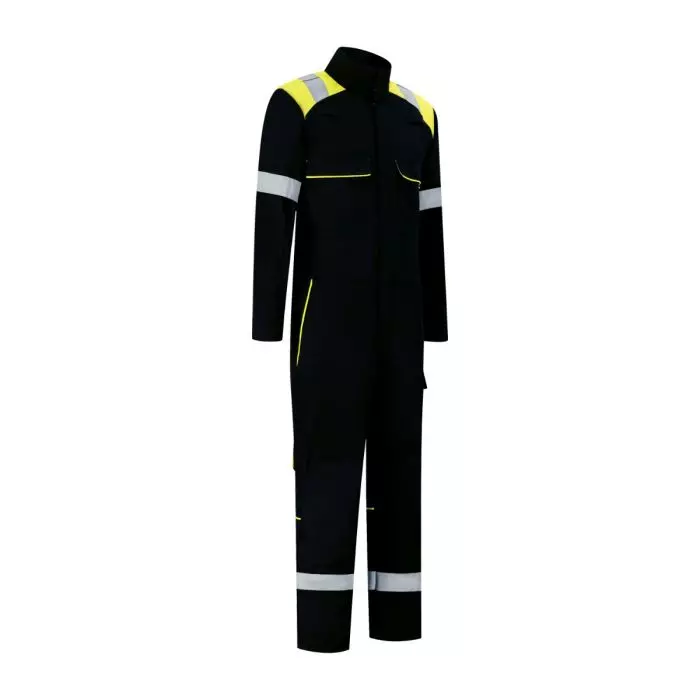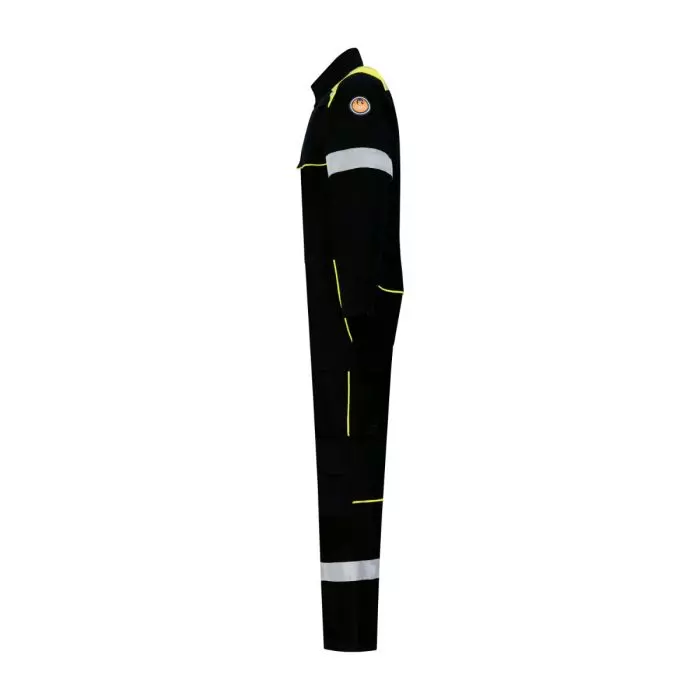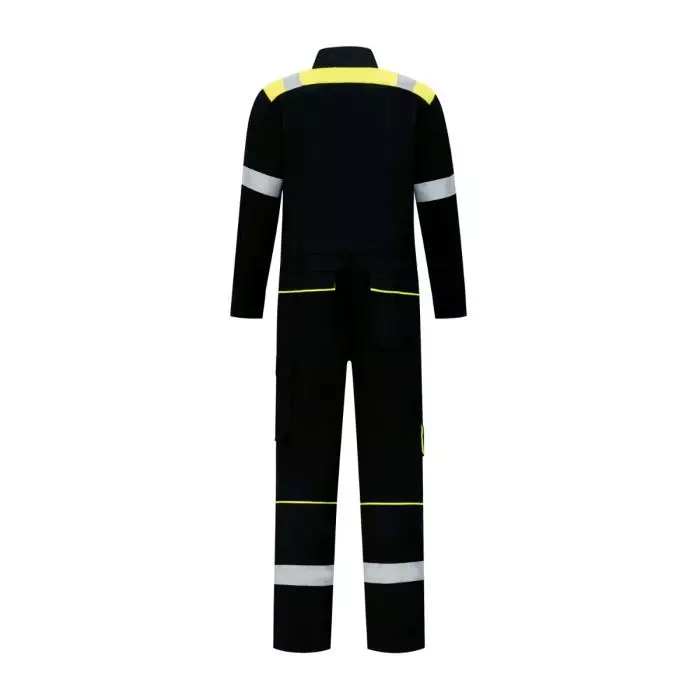Dapro Globe-Tech Coverall, Oil Black/Hi-Vis Yellow
PPE Services
visit storeProduct description
This professional-grade protective coverall combines multiple safety features with ergonomic design for optimal protection in hazardous work environments. Constructed from 99% Guardian fabric with 1% anti-static material and chemical-proof finish, it meets multiple EN ISO safety standards for flame resistance, welding protection, and chemical resistance. The coverall features an innovative design with multiple secure pockets, enhanced visibility elements, and comfort-focused details for extended wear in demanding conditions.
Product Features:
- Extra high protective collar
- Center front with welding flap and concealed flame-retardant snap buttons
- Gas detector loops on chest
- Ergonomically shaped arms
- Multiple safety pockets:
—Chest pockets with safety flap and zipper
—Slanted side pockets with safety flap
—Back pockets with safety flap
—Cargo pocket with double snap closure
—Diamond tool pocket
—Shaped kneepad pockets
- Adjustable features:
—Cuffs with flame-retardant snap buttons
—Elastic waistband
- Enhanced comfort elements:
—Back pleats with 45° tack
—Side vents behind pockets
- Safety visibility features:
—Hi-vis accents at shoulders
—Reflective piping details
—Prolux® 50mm flame-retardant reflective striping
Technical Details:
- Fabric: 99% Guardian, 1% Anti-Static
- Weight: 240-260 GSM
- Chemical Proof Finish
- Care Instructions:
—Machine wash at or below 60°C
—Tumble dry at low temperature
—Iron at low temperature
—Dry clean (except trichloroethylene)
Standards:
- EN ISO 11612:2015 A1 B1 C1 E1 F1
- EN ISO 14116:2015 Index 3
- EN 1149-5:2008
- EN ISO 11611:2015 A1 Class 1
- EN 13034:2005+A1:2009 Type 6
- IEC 61482-2:2009 Class 1
Defines the types and placement of pockets on overalls, affecting storage capacity and accessibility for tools, equipment, and personal items during work.
Measures fabric density in grams per square meter, affecting durability, protection level, comfort, and suitability for different work environments.
Determines how the waist area fits and adjusts, affecting comfort and security of the coveralls during movement and work activities.
- Electrical Protection
- Machine Washable
- Welding
- Heat & Flame Resistance
- Chemical Resistance
- Arc Flash Resistance
- High Visibility
Request a free sample
Test first and buy later. Visit any product page to request your free sample.
Standards and labels
EN 1149-5:2008 is a European standard that specifies the requirements for electrostatic dissipative (ESD) gloves. The standard defines performance requirements for material, design, and testing of ESD gloves. The gloves must be able to effectively discharge static electricity and protect the wearer from ESD. Testing includes measuring the surface resistance of the glove material. Pass/fail results are based on the gloves meeting or not meeting the specified requirements.
Test results
Material Performance TestedThe EN 1149-5:2008 standard specifies the performance requirements for material used in protective clothing designed to avoid incendiary discharges. The test result Tested means that the material has undergone relevant evaluation procedures to confirm its static dissipative properties. These tests generally involve measuring the electrical resistance of the material in ohms (Ω) to determine its capability to dissipate electrostatic charges and prevent sparking that could ignite flammable substances. The practical implications of this result for the respective product category (like protective workwear for use in explosive atmospheres) are significant, as it ensures that the clothing provides a level of protection against electrostatic discharges, potentially reducing the risk of fire or explosion in environments with flammable gases, vapors, or dusts.
EN 13688:2013 is a European standard that specifies the performance requirements for protective clothing. The standard includes requirements for safety, comfort, and durability, as well as tests for determining these properties. Protective clothing includes items like coveralls, aprons, and gloves that are worn to protect the wearer from hazards. Possible test results include resistance to chemicals, heat, abrasion and tearing, as well as breathability and comfort. The clothing can be tested under different conditions to check if it meets the standard's requirements.
EN 61482-2:2020 is a European standard that sets safety requirements for protective clothing against electric arc thermal hazards. This standard specifically deals with the protection of the body and limbs (excluding hands and feet) against electric arc thermal hazards from an electric arc. It defines the performance levels for protective clothing, including the level of protection against electric arc thermal hazards, the arc thermal performance and the classification of clothing. The standard also includes test methods to measure the performance of the clothing, such as measuring the incident energy on the clothing and the flame spread. The test results should show that the clothing meets the minimum requirements for protecting the wearer from electric arc thermal hazards.
EN 13034:2005 is a European standard that outlines the requirements and test methods for Type 6 protective clothing designed to provide protection against liquid chemical hazards. It specifies criteria for the fabric's resistance to penetration by liquid chemicals and establishes guidelines for the overall design and construction of the garments. The amendment A1:2009 introduces updates and refinements to enhance the performance and reliability of Type 6 protective clothing, ensuring improved protection for workers exposed to liquid chemical splashes and sprays. These standards are essential in industries where workers are at risk of encountering liquid chemical hazards, ensuring their safety and well-being.
Test results
Liquid Chemical Protection Type 6EN 13034:2005+A1:2009 specifies the requirements and test methods for protective clothing that provides limited protection against liquid chemicals, designated as Type 6. The 'Type 6' classification indicates that the clothing has been tested and found capable of resisting light spray and minor splashes of liquid chemicals. This test method assesses the fabric's ability to prevent penetration from a synthetic blood solution sprayed at the garment at different angles and pressures, simulating realistic conditions where accidental chemical splashes might occur. Protective clothing that achieves this classification is essential for workers in industries such as chemical manufacturing, painting, or pesticide application, where there is a risk of exposure to harmful liquids but full immersion is not expected, thus enhancing worker safety by providing sufficient protection in low-volume chemical exposure scenarios.
EN 11611:2015 is a European standard that specifies the requirements for protective clothing for use in welding and allied processes. This standard defines performance requirements for material, design, and testing of clothing that protects the wearer from heat and flames. Testing includes measuring the clothing's resistance to heat and flame, as well as its ability to self-extinguish. Pass/fail results are based on the clothing meeting or not meeting the specified requirements.
Test results
Welding Protection Class 1The standard EN 11611:2015 establishes criteria for protective clothing used during welding and allied processes, specifically regarding safety to reduce the risk of harm from sparks, spatter, and other hazards associated with welding. In this context, a Class 1 test result indicates the clothing provides basic protection suitable for less hazardous welding techniques where lower levels of spatter and radiant heat are anticipated. The test for this classification involves subjecting the fabric to controlled ignition and monitoring its resistance to flame spread, heat transfer, and the formation of holes. The fabric material must neither ignite nor continue to burn after the source of ignition is removed. In practical terms, products achieving Class 1 under EN 11611:2015 are suitable for types of welding that produce lower spatter and radiant heat, making them ideal for less intense welding operations but not for those that involve higher risks that might require more robust protective gear categorized in higher classes.
EN 11612:2015 is a European standard that specifies the requirements for protective clothing against heat and flame. This standard defines performance requirements for material, design, and testing of clothing that protects the wearer from heat and flames. Testing includes measuring the clothing's resistance to heat and flame, as well as its ability to self-extinguish. Pass/fail results are based on the clothing meeting or not meeting the specified requirements.
Test results
Flame Spread Test Index 3EN ISO 14116:2015 is a European standard established to assess the flame spread characteristics of protective clothing materials, with the aim of ensuring the safety of individuals working in environments with potential fire hazards. Its purpose is to evaluate the flame retardant properties of protective clothing and mitigate the risk of burn injuries. A designation of Index 3 indicates a limited level of flame spread performance, suggesting that the material offers moderate protection against the spread of flames. This result implies that the material may resist ignition to a certain degree and exhibit slower flame propagation compared to materials with lower index values. The test method used to determine this result typically involves subjecting the material to a controlled flame exposure and assessing the extent and speed of flame spread. Practical implications of this result for the product category include indicating that the protective clothing may provide adequate protection in environments with moderate fire risk, but additional precautions or higher levels of flame-resistant clothing may be necessary in higher-risk scenarios to ensure optimal safety for workers.
CE Marking is a label that shows a product meets certain safety and environmental standards set by the European Union. To get the CE Marking, a company must test and certify their product meets these standards. CE Marking is required for many products sold in the EU, including electronics, machinery, toys and medical devices. It helps ensure that products are safe for consumers and the environment, and allows for easy trade within the EU.
PPE Services delivery terms
Free delivery for all PPE Services products
1 466,41 kr
Free delivery
Sold in units of one piece
Need larger quantities?
Other products you may like
Recently viewed
Need help?
Get help from our experts
Other products you may like
Similar products you may like
Autonomous sourcing platform
The most efficient way to source and order supplies for your operations
Sourcing
Ordering
List products you’re looking for and we’ll find the best products and prices for you – all for free.
Need help?
Get help from our experts





